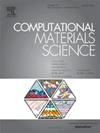Structural study of B-N Co-doped carbon dots: Comparison of spectroscopic analysis using DFT
IF 3.3
3区 材料科学
Q2 MATERIALS SCIENCE, MULTIDISCIPLINARY
引用次数: 0
Abstract
Understanding the internal geometric structure of boron–nitrogen (B–N) Co-doped carbon dots (CDs) is crucial for tailoring their properties to meet the requirements of advanced applications in bioimaging, sensing, and photovoltaics. In this study, a comprehensive Density Functional Theory (DFT) analysis was conducted to investigate the formation and arrangement of individual layers within B–N Co-doped CDs—an area that remains insufficiently explored. Thirteen distinct putative ground-state geometries were identified using the B3LYP/6-31G* level of theory. These structures were selected based on experimental insights into the material’s chemistry and correspond to low-energy local minima. While they may not represent the absolute minimum configuration, they are physically plausible and relevant for modeling the diversity of bonding environments within B–N Co-doped CDs. Comparison between theoretical and experimental FTIR and Raman spectra revealed that no single structure fully accounts for the observed spectral features. However, a composite model—constructed by combining spectra from several low-energy configurations with assumed equal statistical weight—showed significantly improved agreement with experimental data. These results suggest that B–N Co-doped CDs exhibit a heterogeneous internal architecture composed of a mixture of closely related molecular structures. This work provides new insights into the structural complexity of doped carbon dots. It offers a solid theoretical basis for guiding future efforts to optimize their electronic and optical properties for a broad range of technological applications.

硼氮共掺杂碳点的结构研究:DFT光谱分析的比较
了解硼氮(B-N)共掺杂碳点(CDs)的内部几何结构对于调整其性能以满足生物成像,传感和光伏等先进应用的要求至关重要。在这项研究中,进行了全面的密度泛函理论(DFT)分析,以研究B-N共掺杂cd中单个层的形成和排列,这是一个尚未充分探索的领域。使用B3LYP/6-31G*水平理论确定了13种不同的假定基态几何形状。这些结构的选择是基于对材料化学的实验见解,并对应于低能局部最小值。虽然它们可能不代表绝对最小配置,但它们在物理上是合理的,并且与模拟B-N共掺杂cd内键环境的多样性有关。理论和实验的FTIR和拉曼光谱对比表明,没有一个单一的结构可以完全解释观测到的光谱特征。然而,在假设统计权重相等的情况下,将几个低能构型的光谱组合在一起构建的复合模型与实验数据的一致性显著提高。这些结果表明,B-N共掺杂CDs表现出由密切相关的分子结构混合物组成的异质内部结构。这项工作为研究掺杂碳点的结构复杂性提供了新的见解。它为指导未来优化其电子和光学特性以实现广泛的技术应用提供了坚实的理论基础。
本文章由计算机程序翻译,如有差异,请以英文原文为准。
求助全文
约1分钟内获得全文
求助全文
来源期刊

Computational Materials Science
工程技术-材料科学:综合
CiteScore
6.50
自引率
6.10%
发文量
665
审稿时长
26 days
期刊介绍:
The goal of Computational Materials Science is to report on results that provide new or unique insights into, or significantly expand our understanding of, the properties of materials or phenomena associated with their design, synthesis, processing, characterization, and utilization. To be relevant to the journal, the results should be applied or applicable to specific material systems that are discussed within the submission.
 求助内容:
求助内容: 应助结果提醒方式:
应助结果提醒方式:


